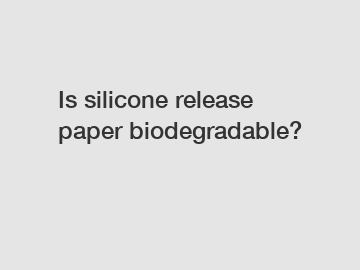Is silicone release paper biodegradable?
Link to Firsta
Silicone release paper has become widely used in various industries for its non-stick properties and ability to release adhesive materials smoothly. However, as concerns for the environment continue to grow, there is a growing demand for sustainable and biodegradable alternatives. In this article, we will explore the question – is silicone release paper biodegradable?
What is silicone release paper?

Silicone release paper, also known as silicone-coated paper or silicone baking paper, is a type of paper that has been coated with a layer of silicone on one or both sides. This coating creates a non-stick surface that is resistant to heat, moisture, and chemicals, making it ideal for use in various applications such as baking, packaging, and labeling.
Silicone release paper is commonly used in the food industry to line baking trays or molds, preventing food from sticking and making cleanup easier. It is also used in the manufacturing of self-adhesive labels and tapes, where the release liner protects the adhesive until it is ready to be applied.
Is silicone release paper biodegradable?
Unfortunately, silicone release paper is not biodegradable. The silicone coating used on the paper is a synthetic polymer that is derived from silica, a naturally occurring mineral. While silicone itself is technically biodegradable under certain conditions, the process can take hundreds of years to complete.
Additionally, the paper itself may not be biodegradable either, depending on the type of paper used and any additional coatings or treatments applied. Therefore, even if the silicone coating were to break down over time, the paper base may still remain intact, further contributing to environmental waste.
Are there any environmentally-friendly alternatives?
As the demand for sustainable packaging and materials continues to rise, manufacturers are exploring alternative solutions to silicone release paper. One possible option is the use of compostable or biodegradable paper coatings that can provide similar non-stick properties without the long-term environmental impact.
Some companies are also experimenting with plant-based or biodegradable polymers as alternatives to silicone coatings. These materials are designed to break down more easily in the environment, reducing the overall environmental footprint of the product.
In addition to exploring new materials, manufacturers can also consider improving the recycling and recovery options for silicone release paper. By developing systems for collecting and recycling used paper and silicone coatings, the industry can reduce the amount of waste produced and lessen its impact on the environment.
In conclusion, while silicone release paper is not currently biodegradable, there are ongoing efforts to develop more sustainable alternatives that can provide the same benefits without the environmental drawbacks. By investing in research and innovation, manufacturers can help reduce the environmental impact of their products and contribute to a more sustainable future.
If you have any questions about silicone release paper or are interested in exploring environmentally-friendly alternatives, please feel free to contact us for more information.
If you are looking for more details, kindly visit our website.
Contact us to discuss your requirements of pet film supplier. Our experienced sales team can help you identify the options that best suit your needs.



